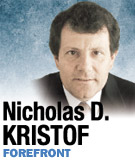Subscriber Benefit
As a subscriber you can listen to articles at work, in the car, or while you work out. Subscribe Now
 The juiciest story behind the Middle East uprisings doesn’t concern Moammar Gadhafi’s “voluptuous” Ukrainian nurse or CIA bags of cash. Rather, it’s the tale of how a nonviolent revolutionary strategy crafted by Serbian students and an octogenarian U.S. scholar came to challenge dictators in Egypt, Tunisia, Bahrain and many other countries.
The juiciest story behind the Middle East uprisings doesn’t concern Moammar Gadhafi’s “voluptuous” Ukrainian nurse or CIA bags of cash. Rather, it’s the tale of how a nonviolent revolutionary strategy crafted by Serbian students and an octogenarian U.S. scholar came to challenge dictators in Egypt, Tunisia, Bahrain and many other countries.
This “uprising in a bottle” blueprint was developed by the Serbian youth movement, Otpor, to overthrow Slobodan Milosevic in 2000. One of Otpor’s insights was that the most effective weapon against dictators isn’t bombs or fiery speeches. It’s mockery. Otpor activists once put Milosevic’s picture on a barrel that they rolled down the street, inviting people to hit it with a bat.
Otpor’s strategy mirrors one promoted by a rumpled Boston academic named Gene Sharp, who is little known in America but inspires tremors among dictators abroad. Sharp’s guide to toppling despots has been translated into 34 languages and was widely circulated in Egypt last year in Arabic.
After Otpor toppled Milosevic, it began to hold seminars for pro-democracy activists from other parts of the world, including many from the Middle East.
“About 15 of us went to Serbia from Egypt,” Mohammed Adel, one of the leaders of Egypt’s awesome April 6 Youth Movement, which helped lead the way in overthrowing President Hosni Mubarak, told me a few days ago. “The methods we learned from Serbia are what we are using in Cairo.”
A crucial lesson, he said, is the power of nonviolence: “If somebody is beating you, don’t attack him. Don’t use any violence against them. Just take photos of them and put them on the Internet.”
Toppling dictators is only one application of this kind of grass-roots movement. One of the most exciting trends in the struggle against poverty and social pathologies such as crime is the use of similar youth-owned movements to change cultural norms from the bottom up.
Tina Rosenberg, a longtime writer and journalist who contributes to the Opinion section of nytimes.com, offers a brilliant look at bottom-up initiatives to achieve social change in her new book, “Join the Club.” My favorite example has to do with teenage smoking.
From the 1970s through the 1990s, nothing seemed to work to dissuade teenagers from smoking. Television commercials warned that smoking kills you or turns your teeth yellow, but teenagers felt invulnerable. And with adults united in disapproval of teenage smoking, what better way for adolescents to rebel than to cough their way through a cigarette?
Then in the late-1990s, some frustrated anti-smoking campaigners showed teenagers how cigarette companies were manipulating them into addiction. Starting in Florida, the teenagers then designed a series of funny and withering commercials, many based on prank phone calls.
The youth campaign spread to other states and avoided any goody-two-shoes message of “don’t smoke.” It channeled kids to rebel against tobacco instead of rebelling by using tobacco. Florida had the biggest one-year drop in high school and middle school smoking of any state in two decades. The high school smoking rate dropped in half in less than a decade.
The team effort to change culture isn’t new. It’s part of the model of Alcoholics Anonymous, Weight Watchers, microfinance lending groups and many initiatives to chip away at poverty, crime and gang violence. Rosenberg cites a housing project area in the District of Columbia, Benning Terrace, where 53 people had been killed in gang violence over two years. Then a group of local ex-convicts and former drug addicts intervened and began working with the gangs.
The ex-convicts had street cred that the police and social workers didn’t, and they worked with young people to make gang violence “uncool.” There wasn’t another gang-related killing for 13 years.
Sometimes the most powerful force for social change is a bunch of irreverent and wise-cracking students, working together.•
__________
Kristof is a New York Times columnist. Send comments on this column to [email protected].
Please enable JavaScript to view this content.
